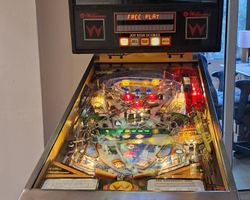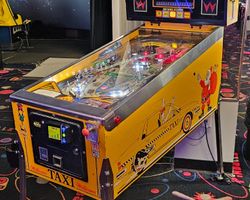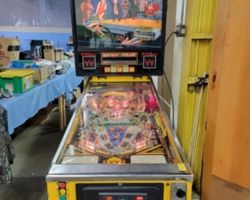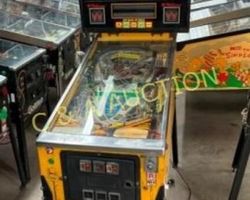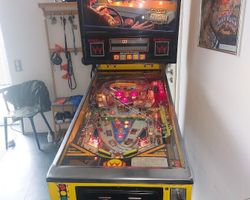Taxi
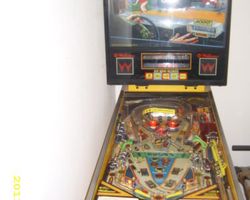
Average Prices: USD $400 to $2,100
Produced: August, 1988
Machine Type: Solid State Electronic
MPU: Williams System 11B
Players: 4
Design by: Python Anghelo, Mark Ritchie
Art by: Python Anghelo
Mechanics by: Tony Kraemer, Craig Fitpold, Mark Kim
Music by: Chris Granner
Sound by: Chris Granner
Software by: Ed Boon
The Williams Electronic Games production "Taxi," released in August 1988, transported players into a whimsical world of urban transit and quirky passengers. This solid-state electronic pinball machine, operating on the robust Williams System 11B, offered a departure from typical themes of the era, leaning into a humorous, fantasy-driven narrative of picking up peculiar fares. With 7,303 units manufactured, Taxi became a notable entry in Williams’ prolific late-1980s output.
The creative team behind "Taxi" brought together a blend of experienced and emerging talents. Design duties were helmed by Mark Ritchie, known for his ability to craft engaging layouts. The distinctive and often surreal artwork was the creation of Python Anghelo, whose unique visual style defined many machines of this period. Chris Granner composed the memorable music and sound design, contributing significantly to the game's immersive atmosphere. Software was programmed by Ed Boon, while mechanical engineering was overseen by Tony Kraemer. The concept itself was a joint effort between Mark Ritchie and Python Anghelo, envisioning a game where players shuttle an eclectic mix of characters. Callouts, essential to the game’s character, featured voices from Barry Oursler, Chris Granner, Mark Ritchie, and Steve Ritchie, contributing to the machine’s comedic charm.
One of the most fascinating aspects of Taxi's production history involves a mid-run artwork alteration. Early "sample" games, estimated at over 200 units, featured a blonde passenger on the backglass and playfield intended to resemble Marilyn Monroe. However, to circumvent potential legal issues regarding image rights, Williams made a swift change. The blonde character was replaced with a brunette, then sometimes a redhead, renamed "Lola." This necessitated updates to the backglass, playfield art, software, and instruction cards. Mark Ritchie indicated that the name "Lola" was humorously chosen from a 1970s song about a cross-dressing character, aligning with the somewhat exaggerated muscular arms depicted for Lola on the backglass. Intriguingly, some rare playfields exist where the character near the center drop target bank remained blonde, while the illuminated insert below changed to a brunette. The game's backglass also includes a subtle nod from Python Anghelo: the taxi driver sports a Special Forces patch, a dedication to Vietnam War veterans. Notably, "Taxi" was Williams' first game to utilize two 16-character alphanumeric displays to present four-player scores, a technical advancement at the time.
Signature Features and Design
"Taxi" stands out due to its bold artistic presentation and integrated mechanical features that enhance its comedic theme. Python Anghelo's art is a central element, saturating the playfield and backglass with vibrant colors and caricatured depictions of the game's unusual passengers. The artwork creates a cohesive and instantly recognizable visual identity, reinforcing the playful, almost absurd, nature of the game’s premise. The backbox is topped with a simple yet effective taxi cab roof light, further cementing the theme.
Beyond the visuals, the machine incorporates several defining mechanisms. A prominent left-side catapult acts as a dynamic shot, physically propelling the ball airborne along a habitrail—a visually engaging event that delivers the ball to a specific target. The "Spin-Out" whirlpool, accessible from the manual plunger lane, serves as a unique skill shot. Players aim for the precise launch to send the ball into this spinning vortex, offering a substantial point bonus. Perhaps the most celebrated mechanical feature is the "jackpot bell" located inside the cabinet. When a jackpot is achieved, this real bell rings continuously for several seconds, providing a loud, tactile, and highly satisfying auditory reward that amplifies the thrill of a major score. These elements work in concert to immerse the player in the lighthearted, fast-paced world of the game.
Playfield and Mechanics
The "Taxi" playfield layout is designed for speed and engaging shot-making, balancing open space with distinct targets and pathways. At its core, the game features two flippers, two slingshots positioned conventionally above the flippers, and three pop bumpers strategically placed to keep the ball active and unpredictable.
Key shots define the playfield's flow: two crossing ramps dominate the upper playfield, providing satisfying loops and opportunities for combo shots. The right ramp, often dubbed the "Gorbie" shot, is crucial for collecting one of the game's passengers. On the left, a kick-out hole feeds directly to the previously mentioned catapult mechanism, launching the ball for the "Drac" shot. Two sets of three-bank drop targets are central to progression, specifically for lighting and collecting passengers. A single standup target provides another direct scoring opportunity. Two kick-out holes in the upper playfield further enhance ball movement, returning the ball to play or initiating specific events.
The layout’s design philosophy promotes a sense of controlled chaos. The ramps offer predictable returns, allowing players to establish a rhythm, while the pop bumpers and drop targets introduce an element of randomness and require precision. The manual plunger delivers the ball into the "Spin-Out" whirlpool, a highly regarded skill shot that rewards a soft plunge with significant points. The artwork on the playfield integrates seamlessly with these mechanics, featuring the stylized passengers at their respective pick-up points and illuminated inserts that guide players through the game's objectives. The lighting scheme emphasizes active targets and modes, signaling progress toward the coveted jackpot. The overall aesthetic is bright and inviting, reflecting the playful tone of the game.
Gameplay Dynamics
"Taxi's" gameplay dynamics are built around a clear, intuitive objective: picking up passengers to light and collect the jackpot. Players must collect five distinct passengers: Marilyn/Lola, Gorbie, Santa, Dracula, and Pinbot (a character cameo from another Williams machine). Each passenger is associated with specific shots or sequences on the playfield. For instance, Gorbie is often tied to the right ramp, while Dracula requires activating the catapult shot.
As players successfully collect passengers, they illuminate inserts on the playfield, signaling progress toward the jackpot. Once all passengers are picked up, the game lights the jackpot shot, which typically involves a timed shot to a designated target or ramp. Successfully hitting this shot triggers the loud jackpot bell inside the cabinet, awarding a substantial progressive score that builds throughout the game. The "Spin-Out" skill shot at the game's start offers an immediate bonus, encouraging precise plunger control from the outset.
The game also features an "Express Lane" multiball, a two-ball mode that provides increased scoring opportunities and a heightened sense of urgency. During multiball, players can try to hit jackpot shots more rapidly or focus on accumulating points from other targets. A "Carry Passenger" feature adds strategic depth, allowing players to retain a collected passenger across different balls or even between players in a multi-player game, easing the path toward the jackpot in subsequent attempts. "Taxi" excels at providing a direct and rewarding gameplay loop: collect passengers, light the jackpot, shoot the jackpot. This straightforward progression, coupled with the immediate feedback of the jackpot bell, creates an engaging and highly replayable experience.
Reception and Legacy
"Taxi" has garnered a consistently positive reception within the pinball community and maintains a strong reputation as an accessible and enjoyable machine. Its strengths are frequently highlighted: the gameplay is described as fast-paced and smooth, offering excellent ball flow that encourages continuous action. Players often praise the game's shot variety, from the two crossing ramps to the distinctive Gorbie and Dracula shots and the satisfying Spin-Out skill shot. The ruleset is considered simple to grasp yet challenging to master, making it appealing to both novice players and seasoned enthusiasts seeking a quick, satisfying game. The "one more game" allure is a common sentiment among players.
A significant factor in its enduring appeal is its unique and humorous theme. The quirky cast of passengers—from the controversial Marilyn/Lola to Gorbie, Santa, Dracula, and Pinbot—contributes to a playful atmosphere. Chris Granner's music and sound design are frequently lauded, with many considering the soundtrack among the best of its era. The memorable callouts further enhance the game’s character. The physical jackpot bell inside the cabinet is a universally praised feature, providing an exhilarating reward for achieving the game's primary objective.
While "Taxi" enjoys widespread acclaim, some minor criticisms have surfaced over time. A few players find the core loop of passenger collection can become somewhat repetitive during extended play sessions. Similarly, Python Anghelo’s distinctive artwork, while largely appreciated, is occasionally described as dated by some, though its unique style is more often considered a strength. Some players also note that the outlanes can be particularly unforgiving, leading to swift drains, though this is often viewed as a minor point, readily adjusted by operators or owners. A few opinions suggest the jackpot can build too slowly or that the overall gameplay depth might be shallow for those seeking more complex rule sets.
Despite these minor points, "Taxi" holds a firm place in pinball history. It is widely considered a "keeper" machine, frequently lauded for its pure fun factor and high replayability. Its integration of a strong theme with engaging mechanical features, all underpinned by an outstanding sound package, showcases the creative zenith of the Williams System 11B era. "Taxi" influenced subsequent designs by proving that unconventional, humorous themes could be highly successful, cementing its status as a beloved and enduring classic.
Sponsored Links
 Ebay Listings
Ebay Listings
 Auction Results
Auction Results
| Cost | Location | Date |
|---|---|---|
| GBP £3,730 |  Winchester, United Kingdom Winchester, United Kingdom |
18 December, 2025 |
| USD $4,500 |  Florida, United States Florida, United States |
07 November, 2025 |
| USD $5,495 |  Texas, United States Texas, United States |
02 October, 2025 |
| USD $3,200 |  Illinois, United States Illinois, United States |
26 April, 2025 |
| EUR €2,000 |  Nordrhein-Westfalen, Germany Nordrhein-Westfalen, Germany |
28 December, 2024 |
| EUR €2,950 |  Nordrhein-Westfalen, Germany Nordrhein-Westfalen, Germany |
28 August, 2024 |
| USD $5,495 |  Ohio, United States Ohio, United States |
28 December, 2023 |
| USD $3,100 |  California, United States California, United States |
22 November, 2023 |
| USD $3,500 |  New Jersey, United States New Jersey, United States |
28 October, 2023 |
| USD $2,950 |  New York, United States New York, United States |
09 August, 2023 |


Private Policy · Search Website · Contact Us
As an eBay Partner, we may earn a commission from qualifying purchases made through links on this site, at no additional cost to you.
All trademarks and copyrighted materials remain property of their respective owners. All other content copyright 2007 - 2026 Pinpedia.

